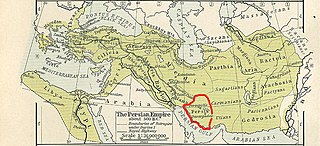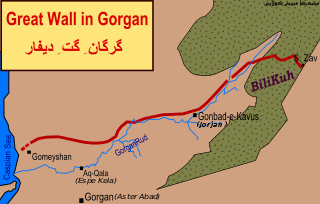
Yazdegerd II, was the Sasanian King of Kings of Iran from 438 to 457. He was the successor and son of Bahram V.

Bahram I was the fourth Sasanian King of Kings of Iran from 271 to 274. He was the eldest son of Shapur I and succeeded his brother Hormizd I, who had reigned for a year.

Bahram IV, was the Sasanian King of Kings of Iran from 388 to 399. He was likely the son and successor of Shapur III.

Shapur I was the second Sasanian King of Kings of Iran. The precise dating of his reign is disputed, but it is generally agreed that he ruled from 240 to 270, with his father Ardashir I as co-regent until the death of the latter in 242. During his co-regency, he helped his father with the conquest and destruction of the city of Hatra, whose fall was facilitated, according to Islamic tradition, by the actions of his future wife al-Nadirah. Shapur also consolidated and expanded the empire of Ardashir I, waged war against the Roman Empire, and seized its cities of Nisibis and Carrhae while he was advancing as far as Roman Syria. Although he was defeated at the Battle of Resaena in 243 by Roman emperor Gordian III, he was the following year able to win the Battle of Misiche and force the new Roman emperor Philip the Arab to sign a favorable peace treaty that was regarded by the Romans as "a most shameful treaty".

Ardashir II, was the Sasanian King of Kings of Iran from 379 to 383. He was the brother of his predecessor, Shapur II, under whom he had served as vassal king of Adiabene, where he fought alongside his brother against the Romans. Ardashir II was appointed as his brother's successor to rule interimly till the latter's son Shapur III reached adulthood. Ardashir II's short reign was largely uneventful, with the Sasanians unsuccessfully trying to maintain rule over Armenia.

Hyrcania is a historical region composed of the land south-east of the Caspian Sea in modern-day Iran and Turkmenistan, bound in the south by the Alborz mountain range and the Kopet Dag in the east.

The Darial Gorge is a river gorge on the border between Russia and Georgia. It is at the east base of Mount Kazbek, south of present-day Vladikavkaz. The gorge was carved by the river Terek, and is approximately 13 kilometres (8.1 mi) long. The steep granite walls of the gorge can be as much as 1,800 metres (5,900 ft) tall in some places. The Georgian Military Road runs through the gorge.

Derbent, formerly romanized as Derbend, is a city in Dagestan, Russia, located on the Caspian Sea. It is the southernmost city in Russia, and it is the second-most important city of Dagestan. Derbent occupies the narrow gateway between the Caspian Sea and the Caucasus Mountains connecting the Eurasian Steppe to the north and the Iranian Plateau to the south; covering an area of 69.63 square kilometres (26.88 sq mi), with a population of roughly 120,000 residents.

Persis, also called Persia proper, is the Fars region, located to the southwest of modern-day Iran, now a province. The Persians are thought to have initially migrated either from Central Asia or, more probably, from the north through the Caucasus. They would then have migrated to the current region of Persis in the early 1st millennium BC. The country name Persia was derived directly from the Old Persian Parsa.

The Great Wall of Gorgan is a Sasanian-era defense system located near modern Gorgan in the Golestān Province of northeastern Iran, at the southeastern corner of the Caspian Sea. The western, Caspian Sea, end of the wall is near the remains of the fort at: 37.13981°N 54.1788733°E; the eastern end of the wall, near the town of Pishkamar, is near the remains of the fort at: 37.5206739°N 55.5770498°E. The title coordinate is for the location of the remains of a fort midway along the wall.

The Gates of Alexander, also known as the Caspian Gates, are one of several mountain passes in eastern Anatolia, the Caucasus, and Persia separating the Greco-Roman world from the Persian world. They are often imagined as an actual fortification, or as a symbolic boundary separating the civilized from the uncivilized world. The original Gates of Alexander were just south of the Caspian Sea, at Rhagae, where Alexander crossed while pursuing Darius III. The name was transferred to passes through the Caucasus, on the other side of the Caspian, by the more fanciful historians of Alexander.

Sakastan was a Sasanian province in Late Antiquity, that lay within the kust of Nemroz. The province bordered Kirman in the west, Spahan in the north west, Kushanshahr in the north east, and Turan in the south east. The governor of the province held the title of marzban. The governor also held the title of "Sakanshah" until the title was abolished in ca. 459/60.

Mazun was a Sasanian province in Late Antiquity, which corresponded to modern-day Bahrain, Qatar, United Arab Emirates, and the northern half of Oman. The province served as a Sasanian outpost and played an important role in the Sasanian efforts to gain control over the Indian Ocean trade, and to establish their dominance in the wealthy regions of Hadramaut and Yemen.

The SasanianEmpire or Sassanid Empire, also known as the Second Persian Empire or Neo-Persian Empire, was the last Iranian empire before the early Muslim conquests of the 7th to 8th centuries. Named after the House of Sasan, it endured for over four centuries, from 224 to 651, making it the second longest-lived Persian imperial dynasty after the Arsacids of the Parthian Empire.

Caucasian Albania was a kingdom in the Caucasus, which was under the suzerainty of the Sasanian Empire from 252 to 636.

The Shapur II's Arab campaign took place in 325, against numerous Arab tribes, due to the Arab incursions into the Sasanian Empire. Shapur II decisively defeated all the Arab tribes during his campaign, and became known as Dhū al-Aktāf to the Arabs, meaning “he who pierces shoulders”.

Sasanian Iberia was the period the Kingdom of Iberia was under the suzerainty of the Sasanian Empire. The period includes when it was ruled by Marzbans (governors) appointed by the Sasanid Iranian king, and later through the Principality of Iberia.

Kirman was a Sasanian province in Late Antiquity, which almost corresponded to the present-day province of Kerman. The province bordered Pars in the west, Abarshahr and Sakastan in the northeast, Paradan in the east, Spahan in the north, and Mazun in the south. The capital of the province was Shiragan.

The Fortifications of Derbent (Darband) are one of the fortified defense lines, some of which date to the times as early as those built by the Persian Sasanian Empire to protect the eastern passage of the Caucasus Mountains against the attacks of the nomadic peoples of the Pontic–Caspian steppe. With the first parts built in the 6th century during the reign of Persian emperor Khosrow I and maintained by various later Arab, Turkish and Persian regimes, the fortifications comprise three distinct elements: the citadel of Naryn-Kala at Derbent, the twin long walls connecting it with the Caspian Sea in the east, and the "mountain wall" of Dagh-Bary, running from Derbent to the Caucasus foothills in the west. The immense wall, with a height of up to twenty meters and a thickness of about 10 feet, stretched for forty kilometers between the Caspian Sea and the Caucasus Mountains, thirty north-looking towers stretched for forty kilometers between the Caspian Sea and the Caucasus Mountains, effectively blocking the passage across the Caucasus. The fortification complex was made a UNESCO World Heritage Site in 2003.
In the history of Azerbaijan, the Early Middle Ages lasted from the 3rd to the 11th century. This period in the territories of today's Azerbaijan Republic began with the incorporation of these territories into the Sasanian Persian Empire in the 3rd century AD. Feudalism took shape in Azerbaijan in the Early Middle Ages. The territories of Caucasian Albania became an arena of wars between the Byzantine Empire and the Sassanid Empire. After the Sassanid Empire was felled by the Arab Caliphate, Albania also weakened and was overthrown in 705 AD by the Abbasid Caliphate under the name of Arran. As the control of the Arab Caliphate over the Caucasus region weakened, independent states began to emerge in the territory of Azerbaijan.



























